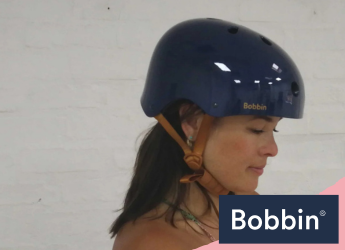Do Adults Need to Wear Bike Helmets?
As the number of cyclists on the road continues to rise, so does the importance of safety precautions. This is particularly true when it comes to protecting our most vital organ: the brain.
One issue that often arises in discussions is whether or not adults need to wear bike helmets. Bike helmet usage for children is widely supported and mandated by law in many places. Yet, the debate surrounding adults and helmet safety remains divided. Some argue it should be a personal choice, while others advocate for mandatory laws.
In this blog, we’ll cover the topic of adult bike helmet usage, examining its importance for cyclists. Here, we’ll explore the risks of cycling without it and the benefits of wearing one.
Understanding the Risks
(Starling Bike Helmet Blueberry)
When it comes to cycling, the risks of not wearing a helmet cannot be overstated. It’s essential to debunk prevailing myths and misconceptions surrounding adult helmet usage. Moreover, shed light on the potential consequences of disregarding this crucial safety measure. That way, adults gain a clearer understanding of helmet safety while on the road.
One misconception is that adult cyclists are less prone to road accidents compared to children. However, statistics paint a different picture. According to studies, a significant number of cycling accidents involve adults. Head injuries are alarmingly common. The severity sustained while cycling without a helmet is a cause for concern. Even a seemingly minor fall or collision can result in a traumatic brain injury (TBI). This can have life-altering consequences.
Another misunderstanding is that experienced cyclists are less likely to experience road crashes. But accidents can occur due to various factors. These include road conditions, unpredictable motorists, or even a momentary lapse in concentration. In a nutshell, all cyclists are vulnerable to accidents, regardless of skill level.
By choosing not to wear a helmet, adults risk compromising their safety and well-being. Neglecting helmet usage also influences others, including children and younger cyclists. But by wearing one, adults can set a positive example and contribute to a culture of safety. This, overall, inspires others to prioritise their well-being while cycling.
The Benefits
(Mirror Mirror Bike Helmet Gold)
Wearing an adult bike helmet is one of the most effective measures an adult cyclist can take. Helmets are designed to provide crucial head protection. Let’s explore the advantages of wearing bike helmets for adult cyclists.
1. Protection against TBI
The purpose of a bike helmet is to safeguard the head and brain from impact during accidents or falls. Helmets are constructed with a protective outer shell and an inner liner. This design absorbs and distributes the energy of an impact. It also helps mitigate the risk of traumatic brain injuries by reducing the force transferred to the skull and brain.
2. Compliance with helmet laws and regulations
In the UK, it’s not legally required for adults to wear helmets in general day-to-day cycling situations. Yet it’s highly recommended by cycling organisations and safety experts. Also, the UK government encourages all cyclists, regardless of age, to wear one as a safety measure.
Helmets may not be mandatory for adults in most situations. But it’s worth noting that wearing one can offer significant cycling protection. It’s an effective safety measure to reduce the risk of head injuries, to add.
Finally, complying with helmet laws helps avoid legal consequences. It also encourages a culture of responsible cycling.
3. Confidence and peace of mind
Beyond protection, wearing a helmet provides adult cyclists with peace of mind. Knowing they have taken a crucial step to mitigate the risks can help ease concerns. They can shift their focus to the pure pleasure of their journey.
Additionally, wearing a helmet can increase visibility on the road. Many helmets come equipped with reflective elements or bright colours. This design makes cyclists more noticeable to motorists, especially in low-light conditions. The enhanced visibility can contribute to overall safety.
Helmet Selection and Proper Fit
There are different types of helmets for adult cyclists, including:
- Road helmets: Designed for road cycling, these helmets are lightweight and aerodynamic. Most also feature ample ventilation to keep you cool during high-intensity rides.
- Mountain bike helmets: Specifically built for off-road cycling. These helmets provide extended coverage to the back of the head. They offer enhanced protection against impacts and falls.
- Commuter helmets: Ideal for urban cycling, commuter helmets prioritise visibility. Most come with integrated lights or reflective elements. They offer a balance between protection and style.
Ensuring a proper helmet fit:
- Place the helmet on your head so that it sits level. The positioning should also cover the forehead without obstructing your vision.
- Adjust the chin straps to form a V-shape under each earlobe. The straps should be snug but comfortable.
- Shake your head gently from side to side and front to back. The helmet should remain securely in place without excessive movement.
Find one that aligns with your cycling needs and enhances your riding experience.
Round-up
One thing becomes clear: helmet safety should be a main concern for adult cyclists. The risks associated with cycling without a helmet cannot be ignored. Moreover, the benefits of wearing one are undeniable.
We’ve learned that helmets significantly reduce the risk of traumatic brain injuries. This habit, as it turns out, safeguards the most vital organ in our bodies.
While helmet laws and regulations vary across regions, the call to prioritise helmet safety for adults remains strong. Overall, wearing one remains a recommended safety practice.
So, the answer to the question “Do adults need to wear bike helmets?” is a resounding yes. Happy and safe cycling!












